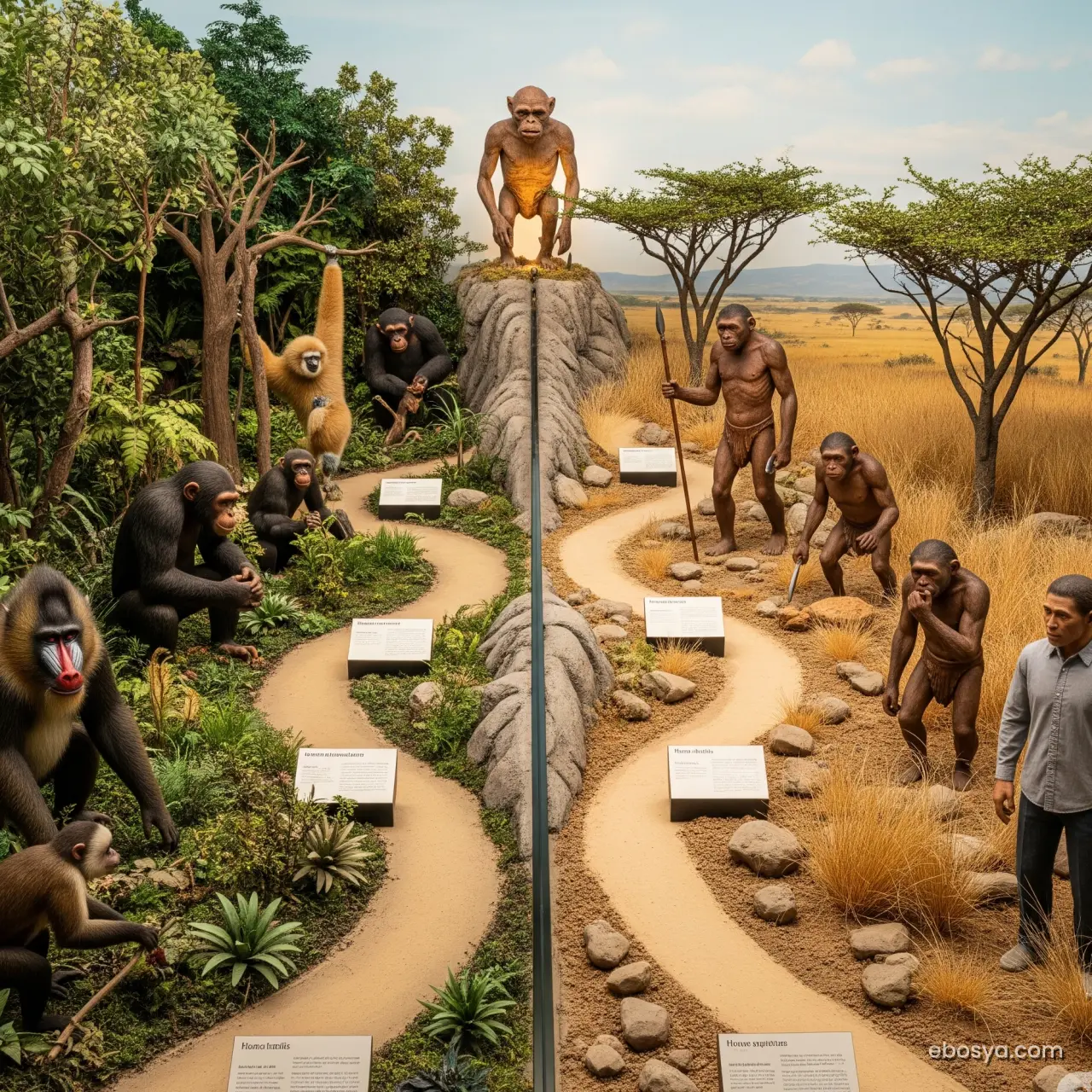“If humans came from monkeys, why are there still monkeys?”
- 🌳 Evolution Isn’t a Ladder — It’s a Tree
- 🧠 Why Monkeys Didn’t “Turn Into” Humans
- 🧬 How Closely Are We Related? The DNA Breakdown
- 🦴 Fossil Evidence: Our Ancient Cousins
- 📚 The Origins of the Myth
- 🧐 Why This Myth Persists
- 🤝 We’re All Family — Just Different Branches
- 🌍 Why Understanding This Matters
- ❓ FAQ — Clearing Up Common Confusions
- 🏁 The Bottom Line
It’s a question that has echoed through classrooms, online debates, and late-night bar conversations for decades. Often it’s said with a smirk, as if the person asking has found a fatal flaw in the theory of evolution.
But here’s the truth:
Humans did not evolve from the monkeys you see today. Instead, we share a common ancestor — a now-extinct primate species that lived millions of years ago.
Once you understand that, the “gotcha” question collapses. And the real story of human evolution turns out to be far more fascinating — and stranger — than most people realize.
🌳 Evolution Isn’t a Ladder — It’s a Tree
The biggest misconception about evolution is picturing it as a straight ladder:
monkeys → apes → cavemen → modern humans.
That’s not how it works.
Evolution is branching, not linear. Think of a family tree: one ancestor at the base, splitting into different lineages over time.
Around 25–30 million years ago, a population of early primates lived in Africa. Some lineages evolved into the monkeys we know today, while others evolved into apes — gorillas, chimpanzees, orangutans — and eventually humans.
Here’s a simplified breakdown:
| Timeline | Event |
|---|---|
| 30 million years ago | Old World monkeys and apes split into separate lineages. |
| 6–8 million years ago | Human ancestors split from chimpanzee ancestors. |
| 2.5 million years ago | Homo genus appears (e.g., Homo habilis). |
| 300,000 years ago | Homo sapiens — anatomically modern humans — emerge. |
So when you see a monkey today, you’re not looking at your ancestor — you’re looking at a distant cousin that took a different evolutionary path.
🧠 Why Monkeys Didn’t “Turn Into” Humans
Here’s the problem with the “monkeys became humans” myth:
It assumes evolution works like a factory assembly line, turning one species into another.
In reality, evolution is about divergence, not replacement.
Imagine this analogy:
Saying humans evolved from monkeys is like saying Canadians evolved from Americans.
-
Americans didn’t disappear — they continued evolving in their own environment.
-
Similarly, the ancestors of modern monkeys stayed monkeys, adapting to their own niches, while another population adapted in different ways, eventually becoming humans.
No single monkey “transformed” into a human. Instead, millions of tiny genetic changes accumulated in separate populations over millions of years.
🧬 How Closely Are We Related? The DNA Breakdown
Genetic evidence tells us exactly how closely related we are to other primates:
| Species | DNA Similarity to Humans | Closest Common Ancestor |
|---|---|---|
| Chimpanzees | 98–99% | ~6–8 million years ago |
| Gorillas | ~98% | ~8–10 million years ago |
| Orangutans | ~97% | ~12–16 million years ago |
| Old World Monkeys | ~93% | ~25–30 million years ago |
| New World Monkeys | ~91% | ~40 million years ago |
Monkeys split off from our lineage long before humans even existed. That’s why they still have traits like tails, smaller brains, and certain bone structures we lost millions of years ago.
🦴 Fossil Evidence: Our Ancient Cousins
If you trace the fossil record, you see a rich tapestry of primates that no longer exist but are part of our evolutionary story. Key examples:
-
Proconsul (20–25 million years ago): An ape-like primate believed to be close to the common ancestor of monkeys and apes.
-
Australopithecus afarensis (3.9–2.9 million years ago): Famous “Lucy” skeleton — walked upright but had a small brain.
-
Homo habilis (2.4–1.4 million years ago): Early toolmaker, bridging ape-like and human-like traits.
These species are neither monkeys nor modern humans — they’re the “in-between” branches that show evolution in action.
📚 The Origins of the Myth
The “humans came from monkeys” idea likely took root after Charles Darwin published The Descent of Man in 1871. Darwin wrote that humans and apes share a common ancestor, but critics and satirists simplified this into the misleading “Darwin says we came from monkeys” slogan.
Victorian-era cartoons exaggerated the idea — often depicting Darwin himself with a monkey body — and the image stuck. Over time, the myth became an easy strawman for opponents of evolution.
🧐 Why This Myth Persists
Even today, the myth lingers for three main reasons:
-
It’s simple — easy to remember, even if wrong.
-
It’s visual — cartoons of monkeys turning into humans are everywhere.
-
It fits intuition — without learning the science, it “feels” like a step-by-step upgrade.
Add in school systems that sometimes oversimplify evolution, and the myth becomes hard to shake.
🤝 We’re All Family — Just Different Branches
In the bigger picture, humans, apes, and monkeys are all part of the primate family.
The differences come from millions of years of adaptation to different environments:
| Trait | Monkeys | Apes (incl. humans) |
|---|---|---|
| Tail | Present | Absent |
| Brain size (relative) | Smaller | Larger |
| Locomotion | Mostly quadrupedal | Many bipedal/knuckle-walkers |
| Habitat range | Wider | More limited |
| Social complexity | High | Very high |
We’re not “better” than monkeys — just adapted for a different set of challenges.
🌍 Why Understanding This Matters
Misunderstanding evolution isn’t just a trivia mistake — it affects how we see ourselves in the natural world. If we think of humans as “above” other animals, it can foster a false sense of separation from the ecosystems we depend on.
Recognizing that we’re part of a broader primate family encourages:
-
Biodiversity conservation — protecting endangered primates.
-
Self-awareness — understanding our own biological limits.
-
Humility — realizing evolution is an ongoing process.
❓ FAQ — Clearing Up Common Confusions
Q: If we share DNA with chimps, why don’t we look the same?
A: Small genetic differences can lead to large changes in traits over millions of years. It’s not just about DNA percentage — it’s about which genes are active and how they’re expressed.
Q: Could monkeys ever evolve into humans?
A: No. Evolution doesn’t work toward a predetermined goal. Monkeys today are already well-adapted to their environments.
Q: Do humans still evolve?
A: Yes! We’re still subject to evolutionary pressures — from disease resistance to dietary adaptation — though the changes happen over long timescales.
🏁 The Bottom Line
Humans didn’t evolve from monkeys — we evolved with them.
We’re not their descendants; we’re their cousins.
Understanding this doesn’t just correct a common myth — it reveals a deeper truth about our place in nature. Evolution is about branching diversity, not a linear march toward “perfection.”
So next time someone drops the “if we came from monkeys” line, you’ll be ready — with the science, the history, and maybe a gentle reminder that humans aren’t as far from the jungle as we like to think.




